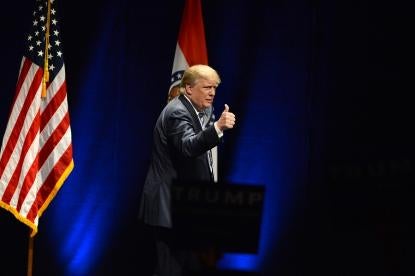With marks such as SHUT THE TRUMP UP!, OBAMA PAJAMA, and REAGAN WORLD, entrepreneurs indefatigably—and unsuccessfully—pursue trademarks that include the names of living presidents. But the quest to register trademarks including the name “Trump” appears to be particularly enticing even though experts warn such an application wastes a filing fee. As of October 21, 2020, a basic word search in the Trademark Office database revealed 206 applications including the word “Obama”, 82 including the word “Reagan”, 25 including “Biden”, but a whopping 862 applications including the word “Trump.” Will the Lanham Act’s “false suggestion” provision and its “particular living individual” bar (sections 2(a) and 2(c)) continue to stand between these applicants and successful registration? Or do these provisions trample on the First Amendment rights of applicants? And what if the proposed trademark makes a political statement?
Although businesses owned by our 45th president or his family members filed many of the 862 trademark applications themselves (and the number of those Trump family applications spiked when Donald Trump started running for president), most of the applicants seeking to register “Trump” trademarks are individuals or businesses hoping to associate their product or service with the President’s machismo. Another significant number seek to subtly or blatantly denigrate the President.
The Trademark Trial and Appeal Board recently denied the registration of two illustrative “Trump” marks. In February 2020, the Board affirmed the denial of registration for a word plus design mark for utility knives that included the words “TRUMP-IT” with the top portion of the letter “T” in “TRUMP” stylized to resemble a wave of hair. (In re ADCO Industries —Technologies, L.P., 2020 USPQ2d 53786 (TTAB 2020)). Applying both section 2(a) and 2(c), the Board denied registration after finding that the marks created a false association with the President and that the President did not consent to use of his name. Then in July, the Board affirmed the rejection of registration for the mark TRUMP TOO SMALL for wearable garments under section 2(c) and concluded that it need not reach consideration of section 2(a)’s false suggestion clauses. (In re Steve Elster, Serial No. 87749230 (July 2, 2020) [not precedential] (Opinion by Judge Cynthia C. Lynch)).
In both cases, the applicants raised constitutional issues alleging that both section 2(a)’s false suggestion clause and section 2(c)’s particular living individual provision are content-based restrictions on private speech subject to strict scrutiny. Therefore, say the applicants, because neither section is narrowly tailored to a compelling state interest, neither can be justified under the First Amendment.
But on the heels of recent Supreme Court decisions in Matal v. Tam, 137 S.Ct. 1734 (2017) (invalidating the mark “The Slants” for an Asian band under section 2(a)’s “disparagement clause”) and Iancu v. Brunetti, 139 S.Ct. 2294 (2019) (invalidating the mark F.U.C.T. for clothing under section 2(a)’s “immoral or scandalous” bar), at least one of the applicants hopes to advance the assault on the Lanham Act’s list of precluded marks. Steve Elster, an intellectual property attorney, filed an appeal in the Federal Circuit challenging the constitutionality of the sections of the statute that barred his “TRUMP TOO SMALL” mark.
Elster’s arguments to the Board zeroed in on section 2(c) which precludes registration of a mark that “consists of or comprises a name . . . identifying a particular living individual except by his written consent. . . .” Elster argued that his trademark, “TRUMP TOO SMALL,” is a political commentary to be displayed on t-shirts with an accompanying hand gesture (Trademark/Service Mark Application, Principal Register, Serial Number 87749230). As Elster sees it, section 2(c) constitutes a content-based regulation and as such must undergo First Amendment strict scrutiny analysis. Therefore, argues the applicant, the government must prove that section 2(c) furthers a compelling state interest and is narrowly tailored to achieve that interest. The government, so the argument goes, has articulated no compelling state interest, and even if it did, the prohibition on trademarks that include the names of presidents is not narrowly tailored to any state interest.
But will the Court’s First Amendment precedent provide Elster sufficient leverage to dislodge section 2(c) of the Lanham Act? Tam and Brunetti established certain foundational principles on which Elster can rely in his quest. First, the Court held that trademarks are private not government speech. Second, the Court distinguished trademark registration from government subsidy programs, making inapplicable prior cases that upheld the constitutionality of government programs that subsidize speech expressing a particular viewpoint.
Nevertheless, the holdings in Tam and Brunetti alone fail to make the case for toppling section 2(c). The Court invalidated the “disparagement clause” and the “immoral or scandalous” bar of the Lanham Act not because they were content-based but because they were viewpoint-based. In contrast, Section 2(c) is a content-based bar that is viewpoint neutral. The Trademark Office used it to preclude “TRUMP-IT” as well as to “TRUMP TOO SMALL,” two marks conveying divergent viewpoints about the President. Tam and Brunetti do not directly address content-based, viewpoint neutral regulations on speech.
To buttress his position, Elster relied heavily in his appeal to the Board on Reed v. Town of Gilbert, a 2015 Supreme Court case invalidating a sign code that imposed more stringent restrictions on signs directing the public to a meeting of a nonprofit than on signs conveying other messages. Reed applied strict scrutiny to the sign code, which, as in most cases, led to the code’s legal condemnation. Elster seeks the same outcome here arguing that any law that targets speech based on communicative content is presumptively unconstitutional. Only regulations narrowly tailored to protect a compelling state interest survive First Amendment strict scrutiny analysis.
But will this argument be persuasive in the Federal Circuit? And what will be left of the Lanham Act if Elster succeeds? If the Reed analysis applies to the rules governing trademark registration, then how could there be rules for trademark registration, which inevitably involve content discrimination? Every subsection of section 2 of the Lanham Act arguably precludes marks based on content.
The Court in Tam and Brunetti treated the trademark registration system as analogous to a limited public forum for private speech. In a limited public forum, some content- and speaker-based restrictions may be allowed, but viewpoint discrimination is forbidden. Although the Court has often applied strict scrutiny to even viewpoint-neutral content discrimination in certain contexts, like the one at issue in Reed, as Justice Sotomayor has explained, the Court need not apply strict scrutiny in the context of the trademark-registration system. (Brunetti at 2315-2316 (Sotomayor, J., concurring in part and dissenting in part)). Rights to trademarks arise from use not registration. The registration system is collateral to the existence and use of the trademarks themselves. If the government eliminated the system altogether, there would be no consequential impact on speech. Under this framework, reasonable, viewpoint-neutral content discrimination is generally permitted.
So what’s left for Elster to argue? Before the Board, Elster made much of the First Amendment’s broad protections of speech about government and public figures. Although this fact may provide an interesting twist to the First Amendment analysis, it may not change the result if the Federal Circuit court applies the limited public forum analysis. In a limited public forum, if a content-based restriction is reasonable in light of the purpose of the forum and is viewpoint neutral, the rule passes constitutional muster. Nothing requires the rule to be the only reasonable limitation or the most reasonable limitation. Consequently, section 2(c) will likely stand as long as the Federal Circuit perceives that the restriction is reasonably related to the purposes of the Lanham Act, a moderate hurdle to clear.
Elster may obtain common law trademark rights by using his “TRUMP TOO SMALL” mark in connection with trade in any market in which he wishes to convey his political message. Elster may disparage Trump in many forums. But even if such detractors succeed with their message, and Trump fails to survive the election, the Court’s precedent suggests that the content-based, viewpoint neutral provisions of the Lanham Act will likely survive First Amendment analysis.




 i
i


